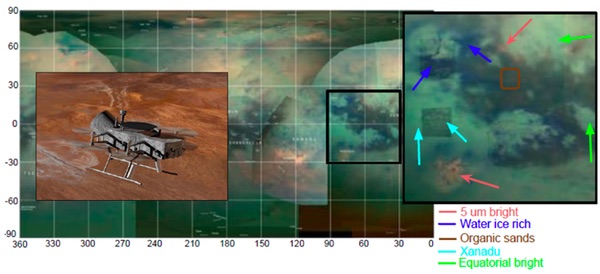The missions proposed for the New Frontiers programby Van R. Kane
|
| The selection of any of these missions would significantly advance planetary science. NASA will choose among them based on two criteria: Would the proposed mission likely meet its scientific goals? And how feasible is the mission technically within the budget cap? |
New Frontiers missions are a key component of NASA’s program to explore the solar system. Like Goldilocks’ bears, NASA’s planetary missions come in three sizes. At the low end, costing $600–700 million, are the more frequent Discovery missions that address tightly-focused questions on (for planetary exploration, at least) tight budgets. NASA plans to fly several Discovery missions in the coming decade. At the high end, typically costing more than $2 billion, are the flagship missions that host a wide range of instruments for in-depth studies. NASA typically flies just one flagship mission a decade, although the next decade will see two launches, the Mars 2020 rover and the Europa Clipper.
However, there are a range of missions that the scientific community deems essential to understanding the solar system that can’t fit within the Discovery program, but don’t require a Flagship mission. This is the role of the New Frontiers program with missions costing around $1 billion with a planned flight rate of two per decade.
The list of possible missions for the New Frontiers program are pre-selected by a panel of scientists once a decade in a process that sets exploration priorities, known as the Decadal Survey. For this current competition, NASA’s managers added two additional targets, Saturn’s moons Enceladus and Titan.
The New Frontiers missions that have been publicly described include proposals that emphasize composition measurements to address the formation and evolution of the solar system (the CONDOR, CORSAIR, and CAESAR comet sample return and the SPRITE Saturn probe proposals) or the formation and evolution of terrestrial worlds (the VISAGE, VICI, and VOX Venus proposals and the lunar Moonrise sample return proposal). The proposed ELF and ELSAH Enceladus missions, the Titan Oceanus orbiter, and the Titan Dragonfly rotorcraft would explore their target worlds for habitability and signs of life. The latter two missions also would continue the broader exploration of Titan.
The selection of any of these missions would significantly advance planetary science. NASA will choose among them based on two criteria: Would the proposed mission likely meet its scientific goals? And how feasible is the mission technically within the budget cap of $850 million for the spacecraft, instruments, and mission operations? (Additional costs such as launch would raise the final cost to around $1 billion.) The review process is thorough and daunting; any weaknesses on either criterion can disqualify a proposal or cause it to be ranked poorly compared to its competitors.
NASA expects to select two to three of these proposed missions before the end of this year for further definition and review. The winning mission will be chosen from this short list by mid-2019 for launch no later than 2025. Travel time to the selected destination could be as short as a few days or as long as 12 years.
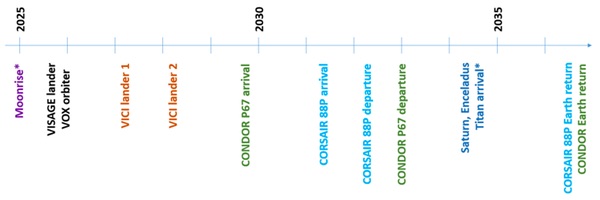 Dates for key events in the proposed New Frontiers missions. Proposing teams have not given dates for the VOX, Moonrise, and Dragonfly missions. Dates shown are my best estimates based on the requirement to launch by the end of 2025 and flight times to reach destinations. |
Venus In Situ Explorer
 Two of the proposed New Frontiers missions would return to land on Venus, another would orbit it. Image from the Soviet Venera 13 lander. (credit: Brown University / Vernadsky Institute / Olivier de Goursac) |
Two key questions have led the two Decadal Surveys (published in 2002 and 2012) to include a mission to directly sample the atmosphere and surface of Venus. The first is how terrestrial planets formed and the second is how Venus evolved from a world that likely had a moderate climate with oceans to its present hellish conditions. As the 2002 Decadal Survey report notes, “Venus and Earth may have had very similar surface conditions early in their histories, but Venus’s subsequent evolution was different from Earth’s, developing an environment unsuitable for life. However, Venus is still a dynamic world with active geochemical cycles and non-equilibrium environments in the clouds and near surface that are not understood.”
To meet the goals of this mission as the Decadal Survey envisioned them, a spacecraft would need to conduct two sets of measurements. First, it would make detailed measurements of the atmosphere’s composition during its descent to and on the surface. The mixture of gases in a planet’s atmosphere, especially the ratios of isotopes of key elements, provides both a fossil record of that world’s formation and evolution and insights into current processes such as surface weathering and volcanic activity. Once on the surface, the craft also would measure the composition of the rocks and soils to allow scientists to reconstruct the processes that initially formed that location and subsequently modified it.
Soviet and American probes in the 1970s and 1980s performed both sets of measurements, but the then-available technology lacked the precision to answer key questions. The two proposed New Frontiers missions would each carry the latest generation of instruments that would provide far more detailed measurements than their predecessors.
| Two key questions have led the two Decadal Surveys (published in 2002 and 2012) to include a mission to directly sample the atmosphere and surface of Venus. The first is how terrestrial planets formed and the second is how Venus evolved from a world that likely had a moderate climate with oceans to its present hellish conditions. |
In the last New Frontiers competition, a Venus proposal led by Larry Esposito of the University of Colorado was a finalist but wasn’t selected to fly, losing out to the OSIRIS-REx mission. Esposito is again leading a team for the current competition, proposing the Venus In Situ Atmospheric and Geochemical Explorer (VISAGE) mission. During the atmospheric descent, the VISAGE craft would use a mass spectrometer to measure atmospheric composition and a suite of instruments to measure the temperature, pressure, and wind profiles. Mass spectrometers are a workhorse instrument for many composition measurements, and you’ll notice that several of the proposed New Frontiers missions would carry one or more. Mass spectrometers “weigh” the material they sample and the distribution of those weights reveal the composition of the atmospheric gases. (Versions also exist that can be used for composition studies of ice and dust particles.)
Once on the surface, a drill on the VISAGE lander would retrieve soil samples from “two depths” and deliver them inside the spacecraft. There, one or more instruments could operate at moderate temperatures to make detailed elemental and mineralogical composition measurements. (The X-ray fluorescence instrument would almost certainly be entirely inside the craft’s pressure vessel. The mission’s visible and near-infrared spectrometer likely also would view the samples inside the craft, but might also examine composition outside the craft through a window.) Cameras to image the surface during the descent and take panoramas after landing would round out the instrument package. Because of the extreme temperatures on the surface, the craft would survive to make measurements for only three hours or so.
The Venus In situ Composition Investigations (VICI) mission would address the same overall goals but with a different emphasis. While the VISAGE mission would accept the complexity of a drill and airlock to bring samples inside the craft for improved soil measurements, the VICI mission would carry a second instrument (a tunable laser spectrometer) in addition to the mass spectrometer for improved atmospheric composition measurements. Tunable laser spectrometers complement mass spectrometers by being able to precisely measure specific isotope ratios and the abundance of key gases such as water, carbon dioxide, and sulfur dioxide.
On the surface, another VICI instrument uses Raman and laser-induced breakdown spectroscopy to study the composition of the rocks and soil. This instrument would fire laser pulses through a window to measure composition at multiple locations near the craft. At lower power but higher wavelength, the laser enables Raman spectroscopy for mineralogical measurements, and at higher power but a lower wavelength the laser melts a tiny portion of the soil or rock for elemental measurements.
Additional VICI instruments would provide further surface measurements. A gamma-ray spectrometer would sense the presence of trace amounts of radioactive elements in the soil through the hull to characterize bulk composition. Like the VISAGE mission, the VICI mission would image the surface during its descent, but there’s no mention of a camera to take panoramic images once on the ground.
The conference abstract describing the VISAGE mission doesn’t mention where on Venus it would land. (In the previous New Frontiers competition, Esposito’s proposed mission would have landed on what is believed to be relatively fresh lava flows.) The VICI mission would target the continent-size tessera highlands that are believed to be the oldest surviving surfaces on the planet. And while the VISAGE mission apparently would deliver a single lander, the VICI mission would deliver two landers.
The Venus Origins eXplorer (VOX) proposal takes an entirely different approach than the other Venus proposals. As proposal team writes, “At the time of the Decadal Survey the ability to map mineralogy from orbit and present-day radar techniques to detect active [surface] deformation were not fully appreciated. VOX leverages these methods and in-situ noble gases to answer [the key] New Frontiers science objectives.”
The key elements of the VOX proposal closely resemble the VERITAS mission that was a finalist for the last Discovery program mission but not selected. The core of the VERITAS proposal was an orbiter that would carry a modern radar instrument to remap Venus and a spectrometer to measure the surface composition and study key aspects of the atmosphere. If selected, the VERITAS mission team was considering proposing a small atmospheric probe call Cupid’s Arrow to toe-dip into the atmosphere to make key composition measurements. A version of that probe now called the Atmospheric Sample Vehicle (ASV) would be included in the VOX mission.
The VOX orbiter would use three instruments to study Venus. A radar instrument would image the surface and map elevations to refine topography measurement at improvements in resolution up to a magnitude better than those made by the Magellan orbiter in the 1990s. The orbiter’s radio signal would be used to map the gravity field at much higher resolution than the Magellan mission to study the interior structure of the planet. The Venus Emissivity Mapper (VEM) would use spectral bands in five near-infrared wavelengths where the atmosphere is transparent to map the surface composition. Measurements in additional bands would study cloud structure and the presence of water vapor in the lower atmosphere.
The ASV would be a small probe released from the orbiter. The probe would enter and briefly traverse the upper atmosphere where it would collect a small sample of the gasses present before its momentum carries it back into space. Once back above the atmosphere, a miniaturized mass spectrometer would measure the composition of key gasses and their isotopes. By only toe-dipping into the atmosphere, the probe doesn’t need protection from the crushing pressures and extremely high heat on the surface that the atmospheric probes of the other New Frontiers Venus proposals require.
Lunar South Pole-Aitken Basin Sample Return
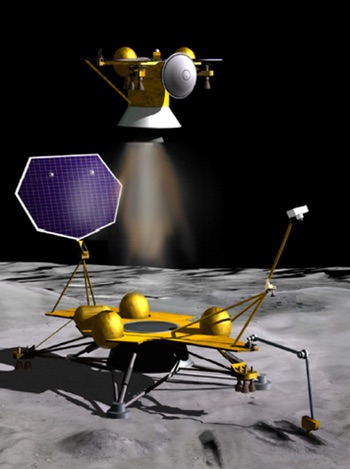 The Moonrise lander and ascent vehicle concept from the last New Frontiers competition. (credit: JPL and the Moonrise team) |
Sample return missions are the ultimate composition-focused missions. Their effective instrument suite for studying the elements and minerals in their returned samples includes all the instruments currently in terrestrial laboratories plus many yet to be developed. Some of the experiments on those instruments likely will be performed by scientists not yet born. The Apollo lunar samples continue to be analyzed 45 years after the last was collected.
No spacecraft could hope to carry instruments that can match the capabilities of the best instruments on Earth. As a result, sample return is often viewed as the end goal of planetary science after the missions of exploration have told us enough about a world or class of worlds to ask detailed, targeted questions. In addition to the lunar and comet sample return missions proposed for this New Frontiers competition, there have been three missions launched to return samples from asteroids, Japan plans to return samples from the Martian moon Phobos, and both the United States and China are working toward returning samples from Mars.
| No spacecraft could hope to carry instruments that can match the capabilities of the best instruments on Earth. As a result, sample return is often viewed as the end goal of planetary science. |
In the case of the Moon, we have samples from a number of locations from the American Apollo and Soviet robotic missions. However, answering many of the specific questions that remain about the Moon require samples from carefully selected new locations. This is driving the Chinese lunar sample return mission planned for the next year and the proposed Moonrise New Frontiers mission.
Over four billion years ago, an impact on the early moon excavated the largest crater in the solar system creating the South Pole-Aitken Basin. The impact exposed buried layers within the crust and appears to have dug into the mantle below. Later volcanic eruptions occurred over portions of the basin creating small mare. Subsequent impacts are believed to have spread material that resulted from these events across the basin. A kilogram or two of soil (technically, regolith) from this basin should include samples from across this basin that would record how the Moon formed and the role of cataclysmic impacts in the history of the terrestrial planets.
The Moonrise lander would touch down within the basin. Its robotic arm then would sieve the surface to collect thousands of tiny (3–20 millimeters) rock fragments because those are what are needed to determine ages and to identify deep-seated materials excavated by the impact. A small bulk sample of the regolith would also be collected.
An ascent vehicle would return these samples to Earth where each rock fragment can be analyzed in detail. Scientists would be able to place the revealed history of each fragment in the context of the evolution of the Moon and the evolution of the Solar System in its first 500 million years using the extensive remote sensing data collected by lunar orbiters and samples from other sites.
In the last two New Frontiers competitions, the Moonrise mission was a finalist for both.
Comet Surface Sample Return
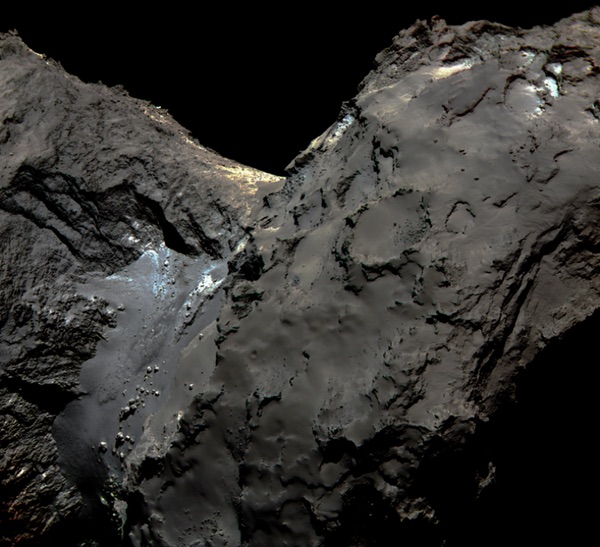 The CONDOR mission would return to comet 67P/Churyumov-Gerasimenko (shown here) to collect two samples for study in terrestrial laboratories. The CORSAIR mission would return studies from a comet, 88P/Howell, that has never been visited by a spacecraft. (credit: ESA/Rosetta/MPS for OSIRIS Team MPS/UPD/LAM/IAA/SSO/INTA/UPM/DASP/IDA; processing by Giuseppe Conzo) |
Because they spent almost their entire history in the deep outer solar system, comets likely preserve ices and organic materials that have undergone little modification over the eons. Scientists are particularly interested in studying the organic material to better understand the processes that created them and to understand what organic material were possibly delivered to the early Earth. Comets are also rich in dust particles that each can tell a story about the materials from which the Sun’s rocky worlds formed. The Stardust mission collected hundreds of dust particles during a high-speed encounter with a comet. However, the collection process necessarily degraded the samples and no ices were collected. To fully understand the history recorded in comets, scientists have made returning minimally-altered samples from a comet their top priority for future comet studies.
The proposed COmet Nucleus Dust and Organics Return (CONDOR) mission would collect up to two samples of material from the surface of comet 67P/Churyumov-Gerasimenko, each of which would be greater than 50 grams in mass. The samples would be collected during brief and gentle touch-and-grabs that would cause little or no modification to the comet material. To get material that would be minimally altered by the Sun’s heat, the samples would include material from up to 15 centimeters below the surface. After collection, the samples would be maintained at less than -20 degrees Celsius during the return trip and refrigerated at -80 degrees Celsius at NASA’s curation facility to prevent alteration of the samples. For materials such as hydrogen cyanide and carbon dioxide that would sublimate at these temperatures, the sample container will trap the gases from these ices for study on Earth.
Many of you likely recognize that the target comet for this mission, 67P, is the same one examined in detail by the Rosetta mission. By returning to this richly-studied comet, scientists will be able to understand the samples acquired within the context of the entire body. The CONDOR spacecraft also will use its camera and measurements of the gravity field to study how 67P has changed during its passes through the inner solar system since the end of the Rosetta mission.
| The ELF spacecraft would focus its studies on what is perhaps the biggest question of all: is there life elsewhere in the universe? |
A second comet mission, COmet Rendezvous, Sample Acquisition, Investigation, and Return (CORSAIR), would sample a comet, 88P/Howell, that has never been visited by a spacecraft. This creates the opportunity to explore a new comet in-depth. Where the CONDOR spacecraft would carry just two instruments (with its radio system for gravity studies an effective third instrument), the CORSAIR spacecraft would carry five instruments to measure the composition of the gases and dust released by the comet and to remotely image and study the surface (plus the radio system) for 10 months. Two samples from at least 10 centimeters below the surface would be collected using a harpoon system along with nine collections of dust gathered from the coma. The samples would not be kept refrigerated; instead, “any volatile ices that are collected are sublimated from the samples and chemically characterized before return” by the spacecraft’s mass spectrometer instrument.
There is reportedly a third comet sample return proposal, CAESAR, led by Stephen Squyres, who has also led the Mars Spirit and Opportunity rover missions.
Saturn Atmospheric Probe
For over a decade, the Cassini spacecraft observed Saturn’s atmosphere to study its composition and weather. Although remote sensing is invaluable for studying and understanding a planet’s atmosphere, there are certain key measurements that remote sensing spacecraft are not capable of providing. In particular, noble gases that carry the signature of the epoch, location, and conditions of planetary formation are undetectable from outside the atmosphere. So are the details of many atmospheric processes including the detailed thermal structure and stability of the atmosphere, the deep cloud structures, and the winds.
The Saturn PRobe Interior and aTmosphere Explorer (SPRITE) mission would deliver a probe to Saturn’s atmosphere. As with the proposed Venus missions, scientists have many questions about Saturn’s formation and evolution that can only be answered by directly measuring the precise composition of its atmosphere with a descent probe. Among those questions are where in the early solar system Saturn formed and what role it played in the possible migration of the giant planets following their formation—first inward and then outward to their present locations. Measurements of the helium abundance could resolve a mystery of why Saturn is much warmer today than simple models of its evolution suggest it should be. A rain of helium deep in the deep atmosphere could be the explanation, in which case helium abundance should be depleted in the upper atmosphere where the probe can make its studies. For these measurements, the SPRITE probe, like the proposed VICI Venus probe, would carry both a mass spectrometer and a tunable laser spectrometer.
Another set of questions for the SPRITE probe revolve around the meteorology of the upper atmosphere. During its approximately 90-minute descent, SPRITE would measure thermal temperature, pressure, and the change in Saturn’s winds from the cloud tops to the deeper atmosphere. SPRITE would also determine the locations and compositions of Saturn’s different cloud decks. Together these measurements will extend Cassini’s remote measurements of Saturn’s meteorology below the level of the highest cloud tops. Prior to entry, a camera on the SPRITE carrier-relay spacecraft would remotely image the atmosphere – both near the probe entry point and globally - so that the probe’s measurements can be understood in their global context and connected back to prior missions equipped with only remote sensing instruments.
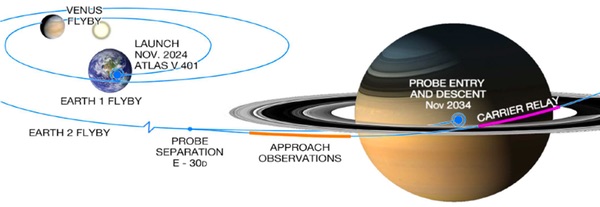 Mission timeline for the proposed SPRITE mission to deliver a probe into the atmosphere of Saturn. (credit: SPRITE team/JPL/NASA) |
Ocean Worlds
Saturn’s moons Enceladus and Titan each have two proposed missions between them, although for one Enceladus mission, I have found only its name, Enceladus Life Signatures and Habitability (ELSAH). The proposers for the other mission, the Enceladus Life Finder (ELF), on the other hand, have provided considerable information their concept. The Cassini mission discovered that this moon is venting material from its internal ocean. Extensive studies of the plumes suggest that this world may have the conditions needed to host life. Cassini’s now-vintage 1990s-era instruments performed extensive studies of Enceladus, but left key questions unanswered. The ELF spacecraft would focus its studies on what is perhaps the biggest question of all: is there life elsewhere in the universe?
| The proposers of the Dragonfly mission propose a rotorcraft that would repeatedly fly up to tens of kilometers between landing sites. Imagine if the Mars rovers had been able to study and sample locations along a traverse hundreds or thousands of kilometers long instead of the tens of kilometers they have been able to do. |
The ELF spacecraft would enter Saturn orbit and repeatedly fly through this moon’s plumes to determine whether its oceans have the conditions needed to be habitable and whether there are complex organic molecules suggesting pre-biotic chemistry or possibly life. The spacecraft would carry three mass spectrometers to study the composition of the gases and ice and dust particles in the plumes. The measurements from these instruments would be far more sensitive than their counterparts on the Cassini spacecraft allowing the mission to address subtle questions of habitability and life. A camera will also take what the mission’s principal investigator, Jonathan Lunine of Cornell University, says will be spectacular images.
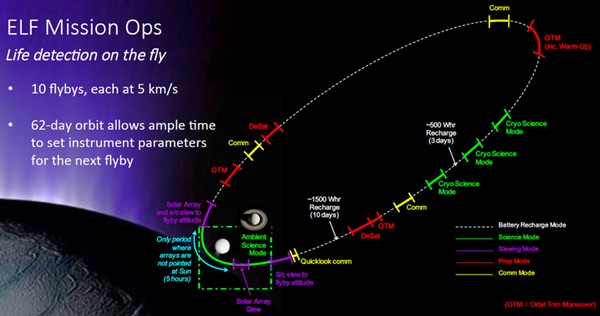 The ELF mission would make ten passes through the plumes of Enceladus to investigate that moon’s habitability and search for signs of life. (credit: ELF team/JPL/NASA) |
The two proposed Titan missions would have more wide-ranging goals than any of the other New Frontiers proposals. Both seek to explore Titan as a diverse world. The Oceanus mission would target the ocean world Titan, first through a series of flybys, and then from orbit for two years. The spacecraft would explore the creation of complex organic molecules by skimming through the upper atmosphere and measuring its composition using a mass spectrometer that has an order of magnitude greater sensitivity, mass resolution, and mass range than the one the Cassini spacecraft carried.
The principal investigator for this proposal, Christophe Sotin with the Jet Propulsion Laboratory, wrote me, “What I find fascinating is that both early Earth and Titan have methane in the upper atmosphere. We have very little information about what happened on Earth as life was emerging. Observing Titan is a window to early Earth to understand what kind of organic chemistry happened there and whether it played a key role in the evolution of life 3.5 billion years ago.” These molecules high in the atmosphere that the Oceanus spacecraft would measure eventually drift to the surface to create organic-rich landscapes.
The spacecraft also would use a camera to observe the surface through the hazy methane-rich atmosphere in three infrared bandwidths to map the distribution of the organics that fall to the surface to understand where they accumulate, how they are transported across the surface, and where they have been eroded. Scientists also would use the camera to map the variability of water ice exposed on the surface. A radar instrument and gravity studies would be used together to understand the structure of the crust and deep interior, including the characteristics of the salty water ocean that lies beneath the crust.
Scientists have two key questions regarding that ocean. Is it in contact with the rocky core of the moon? If so, then key silicate elements needed to support life would be available, as they are believed to be at Europa and Enceladus. And, are the rich deposits of organics and the liquid water brought into contact through processes such as water volcanism or deep impact cratering? If complex organics, water, and silicates are found to mix, the case for Titan as a possible abode for life would be strong.
If selected, there would be an option for the Oceanus spacecraft to make several passes past Enceladus to use its mass spectrometer to study the volatile in that moons plumes. With a single mass spectrometer, however, its studies of the plumes would be more limited than those of the ELF mission.
As a side note, both the ELF and Oceanus spacecraft would use solar arrays to generate their power. Just a few years ago, it was assumed that any mission to the Saturn system would require radioisotope generators for power. Advances in using solar cells together with designs for very large arrays reduces both the cost and complexity of exploring these moons from orbit.
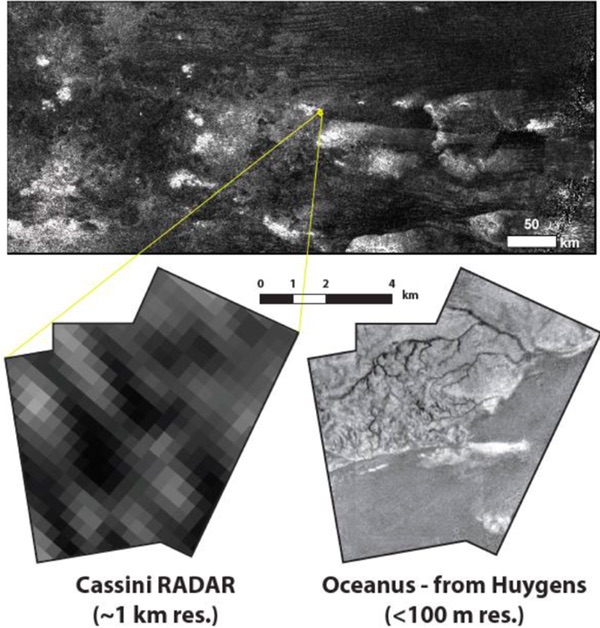 The Oceanus spacecraft would map substantial portions of Titan’s surface in three infrared bands at much higher resolution than the Cassini spacecraft. From its orbit about the moon, the spacecraft will be able to image the surface at 25 meter resolution, about four times higher resolution than in the image from the Huygens probe (bottom left). (credit: Oceanus team/JPL/NASA) |
The second proposed Titan mission may be the most audacious mission that I believe I have ever seen proposed. This moon’s thick atmosphere and low gravity make it the easiest location in the solar system in which to fly. Recent advances in robotic flight make it possible for a craft to autonomously fly and land without direct control. The proposers of the Dragonfly mission combine these two facts to propose a rotorcraft that would repeatedly fly up to tens of kilometers between landing sites. Imagine if the Mars rovers had been able to study and sample locations along a traverse hundreds or thousands of kilometers long instead of the tens of kilometers they have been able to do. The Dragonfly mission would directly explore both the habitability of Titan and search for complex organic molecules that could help us understand how life can arise. It could also search for chemical signs of life on this moon.
The Dragonfly science would be split between flight and landing. While flying, it would remotely study the surface below and measure the composition and vertical structure of the atmosphere. The craft could not continuously fly – it needs to recharge batteries from a radioisotope generator during landings to store enough energy for the next flight. At each landing site, it would study the composition of the organics and ices using both a mass spectrometer and a neutron-activated gamma-ray spectrometer. Titan’s day is 16 Earth days long, so the operations timescale is relaxed and there’s plenty of time to make measurements as well as recharge the batteries. Most of the time is spent on the surface, and in addition to the compositional measurements Dragonfly would use meteorological and seismic instruments to study Titan’s atmosphere and interior.
